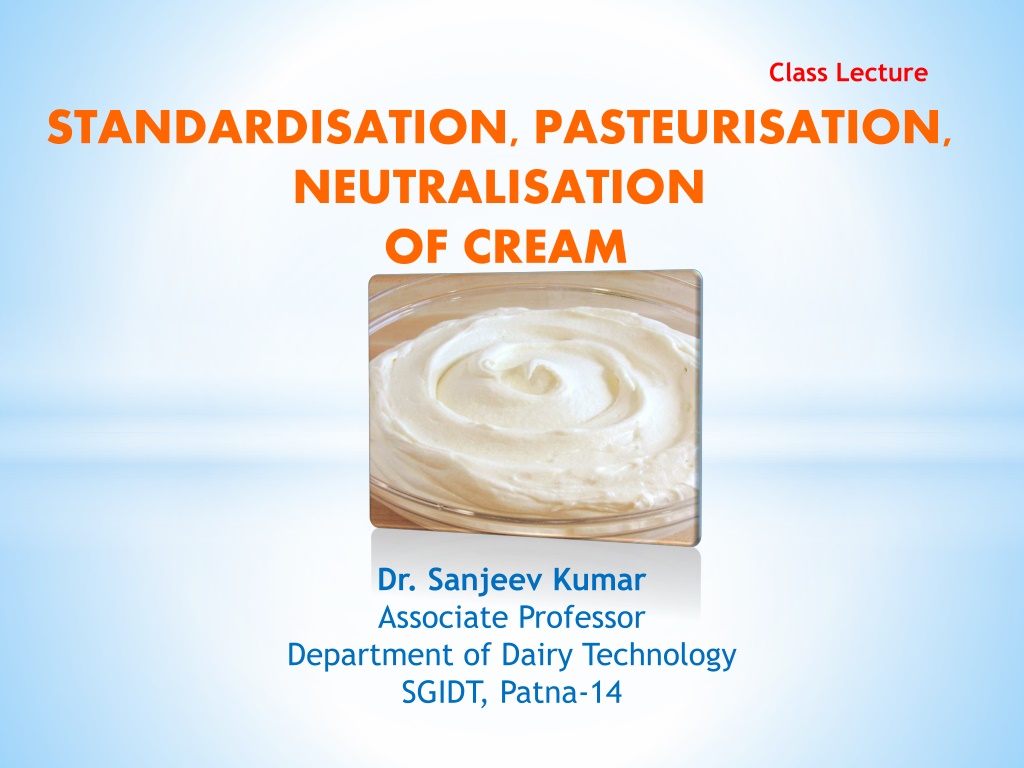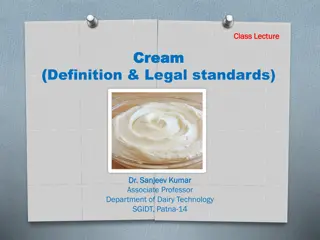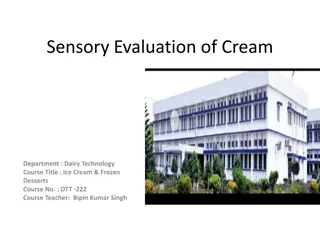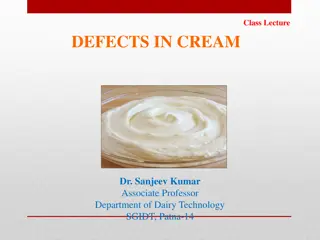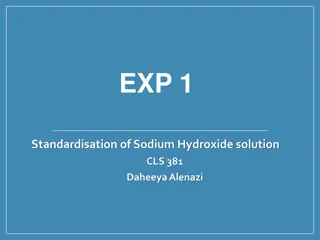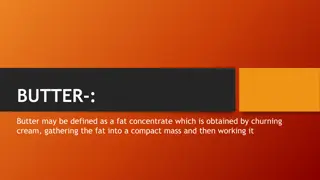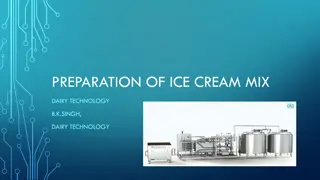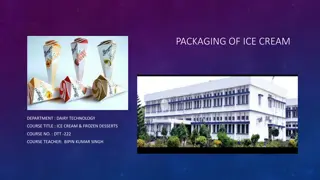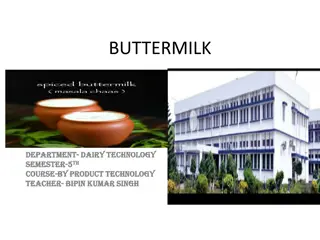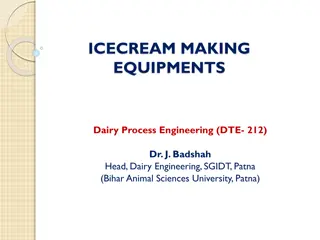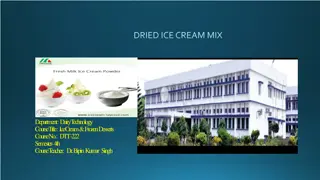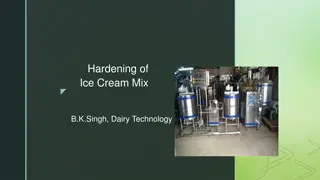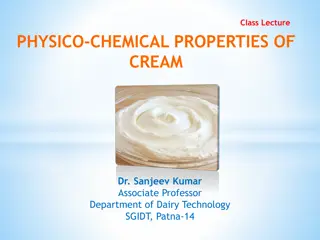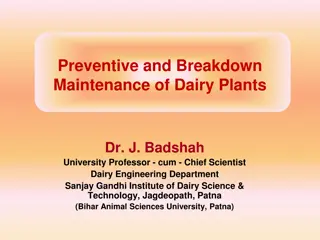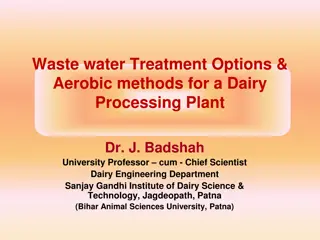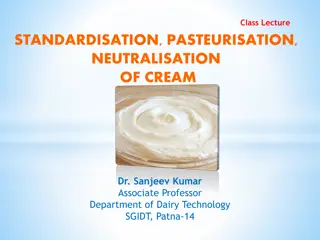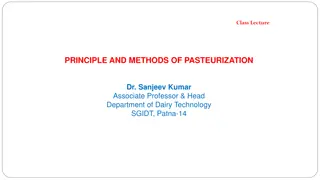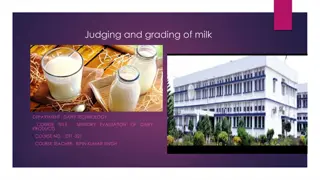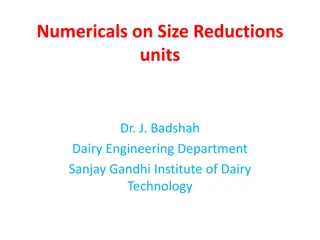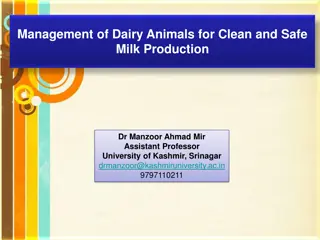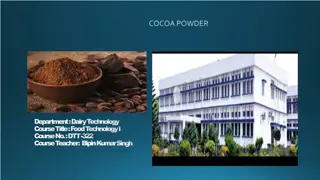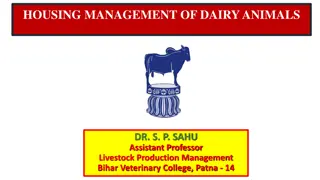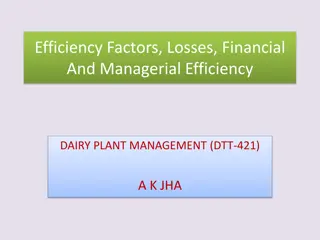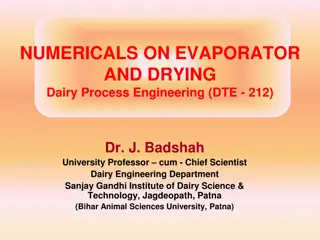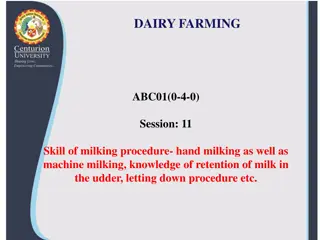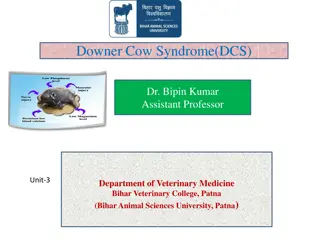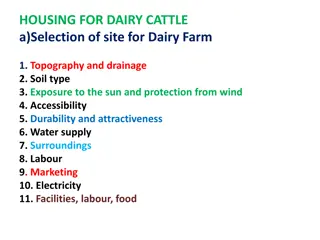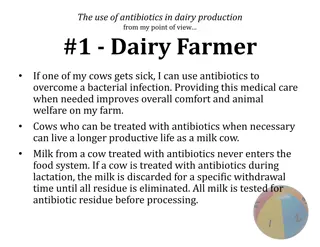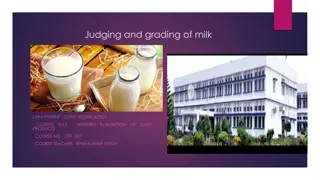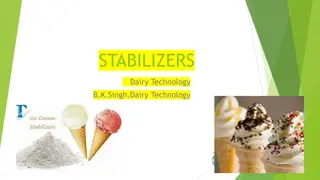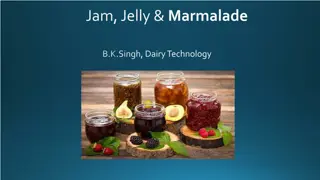Dairy Technology: Standardisation, Pasteurisation, and Neutralisation of Cream
Adjustment of fat content in cream through standardisation, the process of pasteurisation to destroy pathogens and unwanted microorganisms, and neutralisation of cream for butter making. Various methods such as HTST pasteurisation and objectives like fat loss prevention and flavor improvement are covered in this informative lecture.
Download Presentation

Please find below an Image/Link to download the presentation.
The content on the website is provided AS IS for your information and personal use only. It may not be sold, licensed, or shared on other websites without obtaining consent from the author. Download presentation by click this link. If you encounter any issues during the download, it is possible that the publisher has removed the file from their server.
E N D
Presentation Transcript
Class Lecture STANDARDISATION, PASTEURISATION, NEUTRALISATION OF CREAM Dr. Sanjeev Kumar Associate Professor Department of Dairy Technology SGIDT, Patna-14
STANDARDISATION Standardisation adjustment of the fat content in cream to the desired percentage. The fat % in cream is adjusted using adequate amount of skim milk , calculated usually by Pearson's method. PURPOSE: 1) To prepare consumer cream products with fat content to meet legal/quality standards. 2) To avoid economic losses accompanying excess fat content in prepared product. 3) To minimize fat losses in buttermilk. of cream refers to the
EXAMPLE: How much skim milk testing 0.1% fat must be added to obtain 40% fat in the standardised cream, given 1000 kg cream testing 50%? SOLUTION: SOLUTION: From Pearson s square, 39.9 parts by weight of 50% cream, when mixed with 0.1% skim milk, will give 49.9 parts by weight of standardised 40% cream with 10 parts by weight of milk. 50 39.9 40 0.1 10 49.9
PASTEURISATION Pasteurization of cream refers to the process of heating every particle of cream to not less than 71 C and holding it at such a temperature for at least 20 minutes, or to any suitable temperature- time combination, using approved and properly-operated equipment.
OBJECTIVES OF PASTEURISATION To destroy the pathogenic organisms in cream. To destroy the undesirable micro organisms and inactivate the enzymes. To complete the neutralization process in the manufacture of butter. To eliminate some of the gaseous tainting substances. To make possible the removal of some volatile off flavours by vacreation.
HTST(Plate) PASTEURIZATION (95-100 C FOR 15-16 SECONDS) VACCUM PASTEURISATION OR VACREATION (high pressure steam is injected after diluting cream to 6 to 8 % fat) HOLDER PASTEURISATION (71 C FOR 20 MINUTES) METHODS OF PASTEURISATION
NEUTRALISATION OF CREAM FOR BUTTER MAKING Neutralization of sour cream for butter making refers to partial reduction in its acidity. OBJECTIVE- 1.To avoid excessive fat loss in butter-milk ,due to churning of high acid pasteurized cream. 2.To guard against off flavors in cream. 3.To improve the keeping quality of butter made from high acid cream. BUTTER IS GENERALLY STORED AT -23 C TO -29 C
PROCEDURE FOR NEUTRALISATION 1.ADOPTION OF DEFINITE STANDARD OF CHURNING ACIDITY *Butter for long storage cream acidity should be 0.06 to 0.08 *Butter for short storage-cream acidity should be 0.25 to 0.30. 2.Testing correctly for acidity *take sample after thorough mixing *heat cream to boiling point for one minute before testing for acidity *first partially neutralize the cream with known amount of alkali and then treat as above (for acid cream) *determine lactic acidity of cream by titration of a fixed weight (10g) with the standard alkali (n/9 NaOH solution), using phenolphthalein as an indicator.
Correct Amount Of Neutralizer To Be Added Type of Neutralizer Theoretical value (in kg) Practical value (in kg) Sodium bicarbonate 0.93 0.83 Calcium hydroxide 0.41 0.49
The neutralizer used is lower than theoretical value due to the presence of variable amount of carbon-dioxide which raises the titrable value. practical value of sodium bicarbonate Carbon bicarbonate neutralizer and consequently results in over neutralization. dioxide doesn t react with sodium The actual neutralizing capacity of Lime is only 80 percent of the amount used, since nearly 20 % of it reacts with casein and phosphate, and so is not available for acid neutralization.
Characteristics of Neutralizers Particulars Purity Lime Low Soda High Solubility Low High Neutralizing speed Low High Foam production none Variable Cost Low High Over neutralization effect Limy flavor Soapy flavor
Correct procedure for addition of Neutralizer Should never be added dry Should be diluted 10-15 times in clean portable water Should be mixed uniformly and stirred vigorously Temperature of cream should be around 29 C to 32 C, during addition of neutralizer Stirring should be continued for 5-10 minutes after adding neutralizer Then cream should be pasteurized
Double Neutralization of Cream with Lime and Soda First use lime as neutralizer to bring the cream acidity down to 0.3 -0.4% L.A. Next use soda neutralizer to bring the cream acidity to desired level. Objectives To reduce intense flavor effect of single neutralizer used whether lime or soda To avoid production of excessive carbon dioxide by the use of sodium bicarbonate with high acid cream.
